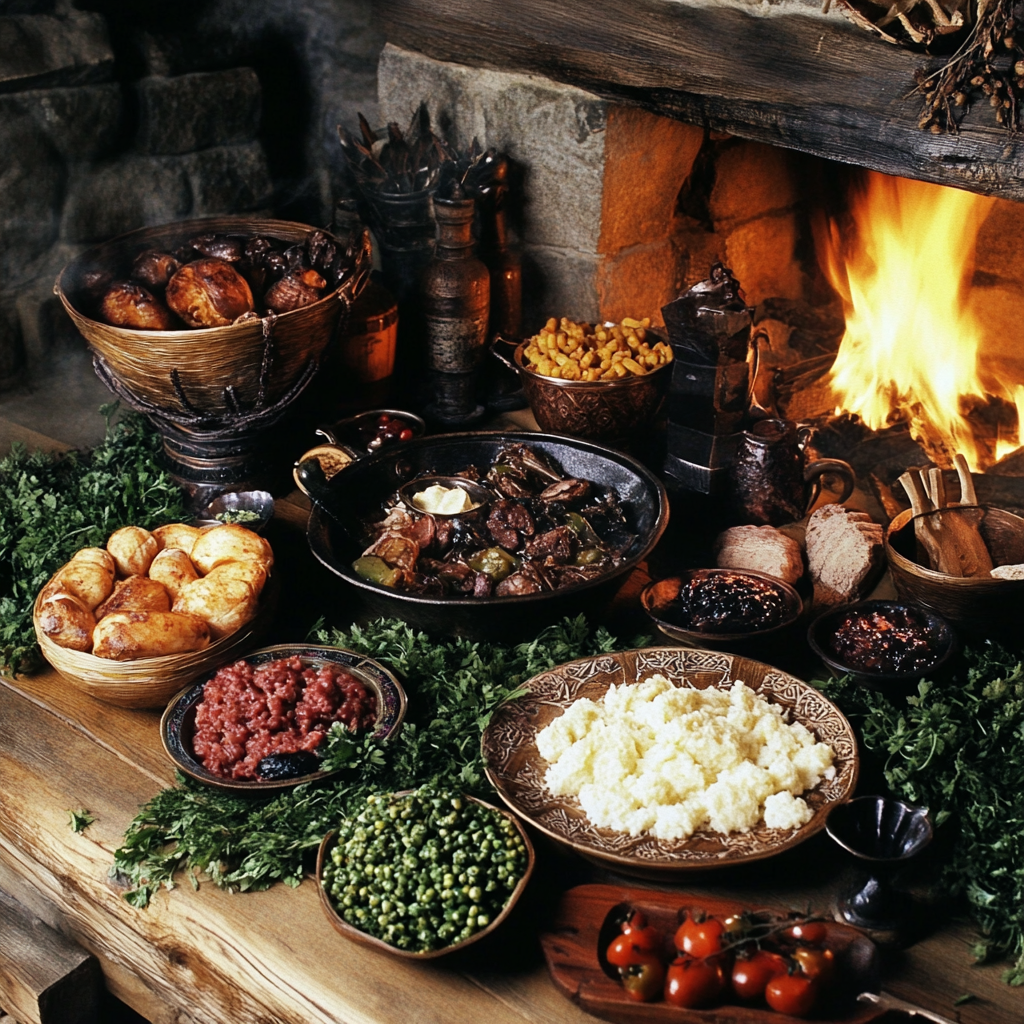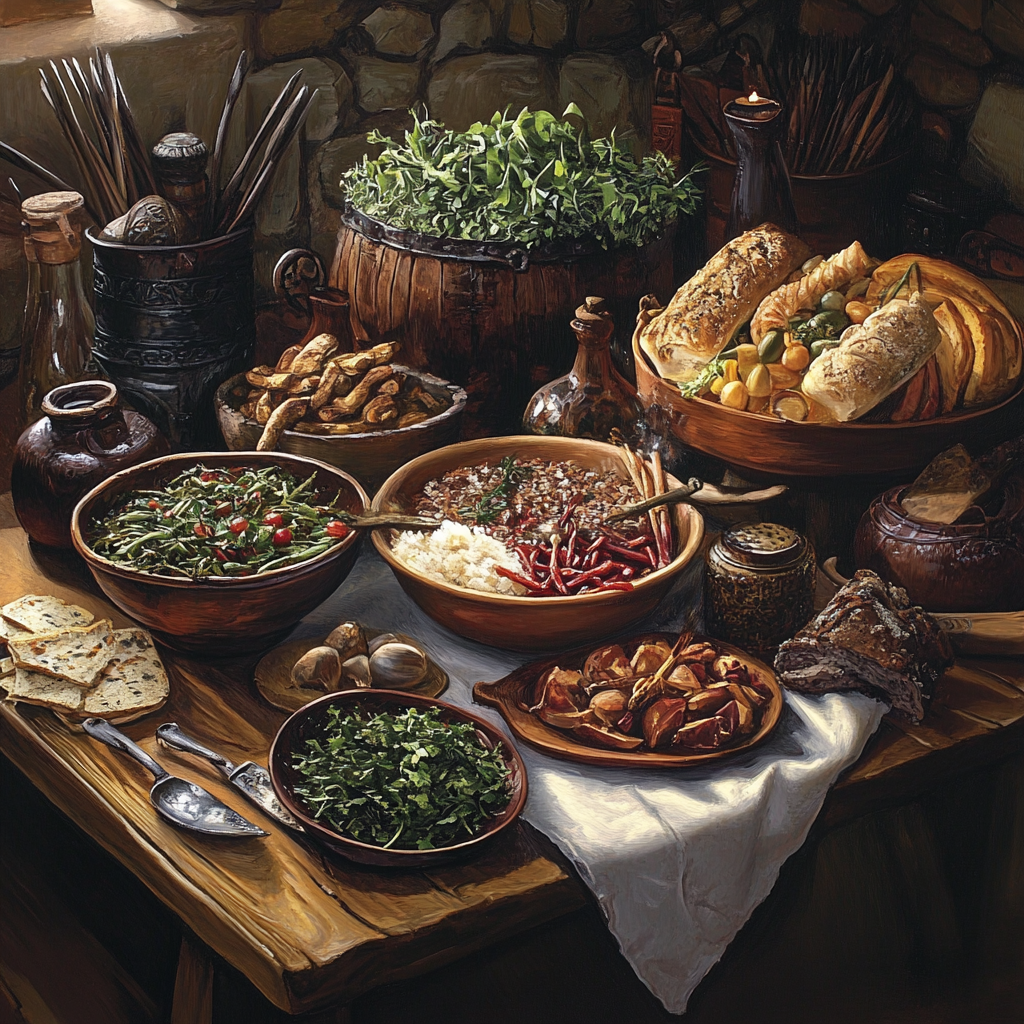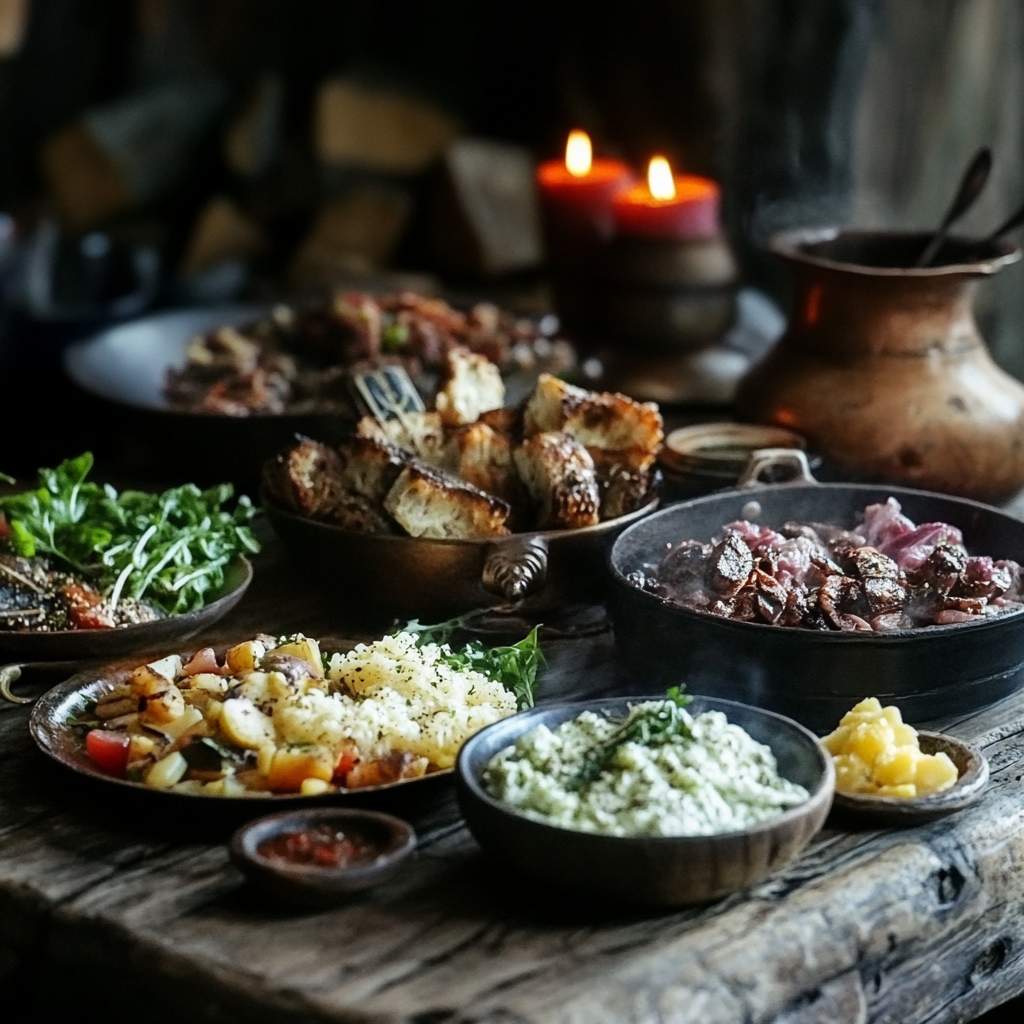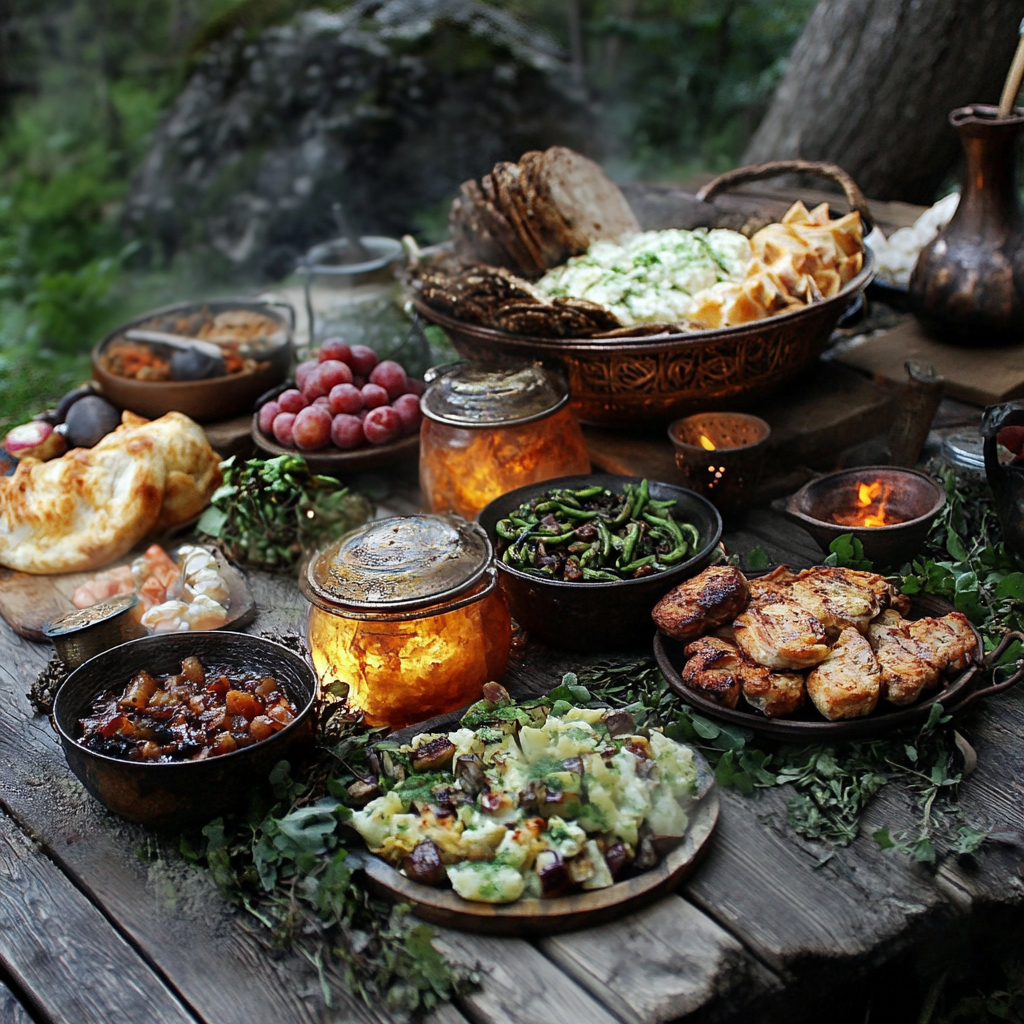
Table of Contents
The world of Norse food recipes is rich, hearty, and steeped in history. Viking cuisine offers a unique perspective into how our ancient ancestors fed themselves, survived harsh winters, and nourished their bodies. If you’ve ever wondered about the foods that fueled the Vikings as they roamed the seas and settled vast lands, you’re in the right place. This comprehensive guide to Norse food recipes will not only introduce you to traditional Viking dishes but also provide a modern twist on these age-old recipes.
1. Introduction to Norse Food Recipes
Norse food recipes are the foundation of what we know as Viking cuisine. The Vikings, who lived in Scandinavia, had a diet that was closely tied to their environment. With a reliance on what nature provided, Viking food was hearty, preservable, and nutritious. Today, many of these dishes remain staples in Nordic countries. In this guide, we will explore the rich tradition of Norse food recipes, showcasing classic Viking dishes and offering tips on how to incorporate them into your own cooking.

Why Norse Food Recipes Matter Today
The importance of Norse food recipes goes beyond just taste. These recipes tell a story of survival, resourcefulness, and the use of local ingredients. For example, many of the Vikings’ preservation methods, like smoking and fermentation, are still used today in modern food practices. By exploring these traditional dishes, you’re not only discovering delicious meals but also connecting with centuries-old culinary traditions.
2. The Foundation of Viking Cuisine
Understanding the foundation of Viking cuisine is essential when exploring Norse food recipes. What the Vikings ate depended heavily on their geography, climate, and available resources. Below, we’ll dive into the primary components of their diet.
Meat and Fish: Essential Protein Sources
In Norse food recipes, meat and fish were the key sources of protein. The Vikings were skilled hunters and fishermen, and they relied on the meat from domesticated animals like cattle, sheep, and pigs, as well as wild animals such as boar and elk. Fish, particularly herring, cod, and salmon, played a significant role in their diet.
Meat and fish were often cooked using methods like roasting, boiling, or smoking. Smoked fish, in particular, became a way to preserve the catch for long winters. This was crucial because fresh food was not always readily available during the colder months.
Grains and Vegetables: Staples in Viking Diets
While protein sources were essential, the Vikings also depended on grains and vegetables. Rye was the primary grain used for baking bread and making porridge. Root vegetables like carrots, turnips, and onions were grown in Viking gardens and incorporated into stews and soups.
Grains were also used for brewing ale, which was a common drink for Vikings. Despite the cold climate, fruits such as berries, apples, and plums were also part of the diet when in season, often enjoyed fresh or preserved.

3. Traditional Norse Food Recipes
Now that we’ve explored the foundation of Viking cuisine, let’s dive into some classic Norse food recipes. These traditional dishes offer a glimpse into the Viking way of life, using simple yet flavorful ingredients.
Viking Meat Stew (Kjøttgryte)
Viking meat stew, known as Kjøttgryte, is a hearty, flavorful dish that can be made with beef, lamb, or any meat available. This stew is filled with root vegetables and herbs, slow-cooked to perfection.
Recipe Details
- Course: Main Dish
- Cuisine: Norse
- Difficulty: Easy
- Servings: 6
- Prep Time: 15 minutes
- Cooking Time: 3 hours
- Calories: 350 per serving
Ingredients:
- 500g beef or lamb, cubed
- 2 carrots, chopped
- 2 potatoes, chopped
- 1 onion, chopped
- 2 cups beef broth
- 2 tablespoons olive oil
- Salt and pepper, to taste
- Fresh herbs (rosemary, thyme, bay leaves)
Instructions:
- Heat olive oil in a pot over medium heat.
- Brown the meat, then add the chopped vegetables.
- Pour in the beef broth and bring it to a boil.
- Add the herbs and lower the heat to simmer.
- Cook for 2-3 hours until the meat is tender.
- Season with salt and pepper, then serve.
Smoked Fish: The Viking Way
Viking smoked fish is a traditional dish that involves curing and smoking fish like salmon or herring. This method preserves the fish for months, making it a valuable food source during the winter.
To prepare smoked fish at home, all you need is your favorite fish, salt, and time. The fish is salted and then smoked over wood chips, creating a rich, smoky flavor that is perfect on rye bread or in stews.
Rye Bread: The Essential Viking Loaf
Rye bread, or “ruggbrød,” was a staple of Viking cuisine. Dense and filling, this bread would provide long-lasting energy and was perfect for pairing with meats, cheeses, and smoked fish.
Recipe Details
- Course: Bread
- Cuisine: Norse
- Difficulty: Moderate
- Servings: 1 loaf
- Prep Time: 15 minutes
- Cooking Time: 1 hour
- Calories: 220 per slice
Ingredients:
- 3 cups rye flour
- 1 ½ cups warm water
- 2 tablespoon salt
- 1 teaspoon dry yeast
Instructions:
- Mix all ingredients into a dough.
- Knead for about 10 minutes, then let the dough rise for 1 hour.
- Shape the dough into a loaf and bake at 350°F (175°C) for 45 minutes to 1 hour.
- Allow it to cool before slicing.
4. Norse Desserts and Sweet Treats
Although the Vikings had a relatively simple diet, they did enjoy sweet treats from time to time. Honey, berries, and nuts were often used to create desserts that were both delicious and nourishing.
Viking Honey Cakes (Honningkake)
Honey cakes, or “Honningkake,” were a popular dessert among the Vikings. These cakes are sweetened with honey and flavored with spices like ginger and cinnamon, making them the perfect treat for special occasions.
Recipe Details
- Course: Dessert
- Cuisine: Norse
- Difficulty: Easy
- Servings: 12
- Prep Time: 15 minutes
- Cooking Time: 20 minutes
- Calories: 150 per slice
Ingredients:
- 1 cup honey
- 2 cups flour
- 1 teaspoon ground ginger
- 2 teaspoon ground cinnamon
- 1,5 egg
Instructions:
- Mix all the ingredients to form a dough.
- Roll the dough out and cut into shapes.
- Bake at 350°F (175°C) for 15-20 minutes.
- Allow to cool before serving.
Simple Berry Desserts
During the summer, berries like strawberries, raspberries, and blackberries were common in Viking diets. The Vikings often paired berries with cream or honey to create a simple yet satisfying dessert.
5. Norse Cooking Techniques
Viking cooking techniques were simple but effective. They relied on methods that allowed them to preserve food for long periods and make the most of what they had.
Roasting Over Fire
Roasting meats and fish over an open flame was a common Viking cooking technique. It not only cooked the food but also imparted a smoky flavor that made it delicious and memorable.
Fermentation: Preserving Food for Winter
Fermentation was crucial in the Viking diet, especially for preserving fish, vegetables, and dairy products. This method allowed the Vikings to store food for the long winter months when fresh produce was unavailable.
6. Modern Interpretations of Norse Food Recipes
Today, many chefs and home cooks experiment with Norse food recipes, creating modern interpretations that still reflect the rich history of Viking cuisine. From smoked salmon to rye bread, these traditional dishes are enjoying a resurgence in contemporary Nordic cuisine.
7. Incorporating Norse Ingredients into Your Diet
If you want to enjoy Norse food recipes at home, start by incorporating ingredients like rye, root vegetables, and fish into your meals. These ingredients are healthy, hearty, and perfect for creating Viking-inspired dishes that will nourish your body and soul.
8. Conclusion
Norse food recipes offer a fascinating window into Viking culture, allowing us to taste history and connect with the past. From hearty stews to sweet honey cakes, these dishes are simple, delicious, and rooted in the traditions of the Norse people. Whether you’re looking to try your hand at Viking cooking or simply enjoy the flavors of the past, Norse food recipes are a perfect way to bring a taste of Viking life to your table.

FAQs
1. What was the main source of protein in Viking food?
Meat and fish were the main sources of protein in Viking food, including beef, lamb, herring, and salmon.
2. Did the Vikings use any spices?
The Vikings had access to a limited number of spices, mostly from trade. They used herbs like thyme and rosemary, but spices were not as common as they are in modern cooking.
3. How did the Vikings preserve food for the winter?
The Vikings preserved food by smoking, salting, fermenting, and pickling to ensure they had enough food during the harsh winters.
4. Can I recreate Viking recipes at home?
Yes! Many Viking recipes, like rye bread and smoked fish, can be recreated at home with simple ingredients and traditional cooking techniques.
5. Why is rye bread important in Viking culture?
Rye bread was a staple of the Viking diet because it provided essential nutrients and was durable, making it perfect for long journeys and long winters.





[…] Viking recipes offer a window into the bold and resourceful culinary traditions of the Norse people. These ancient dishes showcase the ingredients, cooking methods, and cultural practices that defined life during the Viking Age. […]
[…] food recipes for your Webkinz pets is one of the most entertaining parts of the game. The process is simple, but […]
[…] were not common, the Vikings made iron-cooked flatbreads using grains like barley and rye. Modern Viking waffles are inspired by these ancient practices, incorporating wholesome, nutrient-rich […]